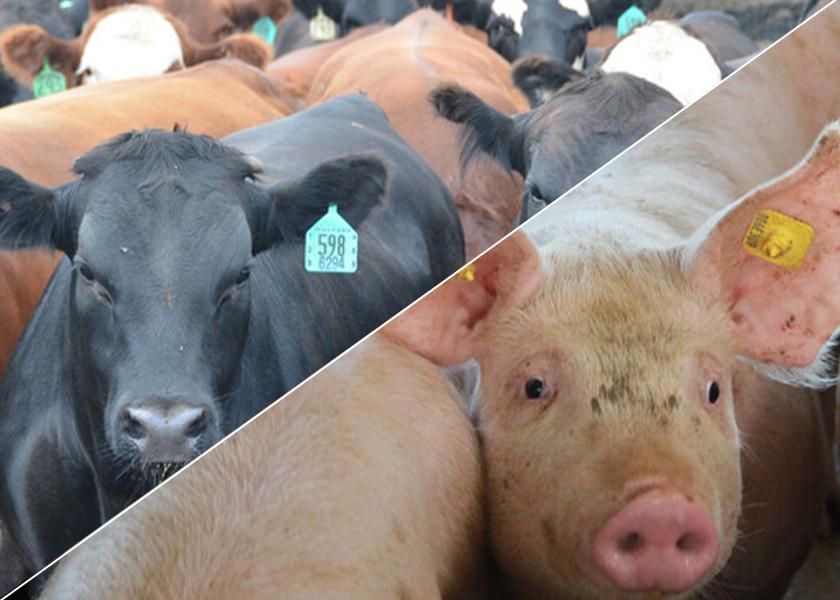Livestock Analysis | September 16, 2022

Price action: October lean hog futures rose 85 cents to $96.90, up $3.725 for the week and the contract’s highest closing price since Aug. 17.
5-day outlook: Hog futures closed at a four-week high on signs a recent cash market slide has bottomed. Rebounds in cash hogs and wholesale prices may continue next week, reflecting improved demand for pork. Pork cutout values climbed back above $100.00 earlier this week and early today gained another $1.92 to $107.77. The CME lean hog index rose 19 cents to $97.77 (as of Sept. 14), up from a seven-month low earlier this week ending the string of daily price declines dating back to Aug. 11. Monday’s index is expected to gain another 20 cents. This week’s hog slaughter totaled 2.465 million head, a 3.1% decline from the year-ago level and implying current supplies are even tighter than previously thought.
30-day outlook: Hog slaughter likely will increase the next two months. The 10-year average implies a rise of about 125,000 from this week’s total to the short-term peak posted during the week before Thanksgiving. Yet, the price pattern implied by the 10-year average for the lean hog index indicates a tendency for cash hog prices to rise from mid-September into mid-October. The rise isn’t particularly large, at a 10-year average of $2.52, but the departure from the general downward trend during the second half of the year will make a big difference for price levels later in the year. The early-fall strength barely showed up last year, so the size of last year’s second-half drop was amplified. We still expect the comparative tightness of this year’s supplies, improved consumer demand and higher cattle prices to translate into significantly higher fourth-quarter prices than seen in late 2021. USDA’s quarterly Hogs and Pigs report Sept. 29 will be a key market influencer.
90-day outlook: Hog supplies will likely grow seasonally into the Thanksgiving season, drop around the holiday, then rebound to annual highs by mid-December. Demand for most pork cuts other than hams and picnics could also prove seasonally weak through much of the period, which is another reason hog prices traditionally fall to annual lows in late fall or early winter. Recent averages point to a low more likely during the year-end holiday season. We still see red meat demand holding up reasonably well despite worsening recession fears, which may reflect consumers dining at home more and eating out less. We expect cash prices to prove the discounts in deferred hog futures are overly large.
What to do: Be prepared to extend feed coverage when market bottoms are in place.
Hedgers: Carry all risk in the cash market for now.
Feed needs: You are hand-to-mouth on corn-for-feed and soybean meal needs.
Price action: October live cattle futures fell 12.5 cents to $145.50, down 17.5 cents for the week. October feeder cattle rose 32.5 cents to $181.25, down $4.325 for the week.
5-day outlook: Live cattle futures next week may follow feeder cattle, looks vulnerable to more technical selling pressure. Cattle market bulls were encouraged by this week’s cash trade, which could support buying interest in futures early next week. Cash cattle trade on Thursday saw packers raise bids, with most prices steady to $1.00 higher than last week. For the week through Thursday morning, USDA-reported live steers averaged $142.73, up from last week’s $142.48 average. Wholesale beef prices were mixed early today after eroding earlier this week. Choice cutout value rose 68 cents to $253.02, while Select fell $2.47. Movement at midday was decent at 92 loads. Traders will closely scrutinize next Friday’s monthly USDA Cattle on Feed report.
30-day outlook: This week’s steady-higher cash cattle trade suggests better packer demand and/or tighter market-ready cattle supplies in the coming weeks. The Choice-Select spread early today widened to $25.54, which is historically wide and suggests the supply of market-ready cattle remains tight. The feeder cattle market will continue be influenced by grain prices and weather in the U.S. Plains and southwest. The southwestern U.S. is expected to remain extremely dry over the next 90 days, suggesting cattle producers in that region may have to liquidate herds due to a lack of forage and hay.
90-day outlook: The U.S. stock market sold off sharply late this week, with the major indexes hitting two-month lows. This week’s hotter-than-expected U.S. consumer price index prompted heightened concerns about an even more aggressive monetary policy tightening pace from the Federal Reserve, which would in turn suggest slower economic growth. If stocks continue a sustained slide, consumer confidence would wane in the fourth quarter and beef demand could slip.
What to do: Be prepared to extend feed coverage when market bottoms are in place.
Hedgers: Carry all risk in the cash market for now.
Feed needs: You are hand-to-mouth on corn-for-feed and soybean meal needs.






